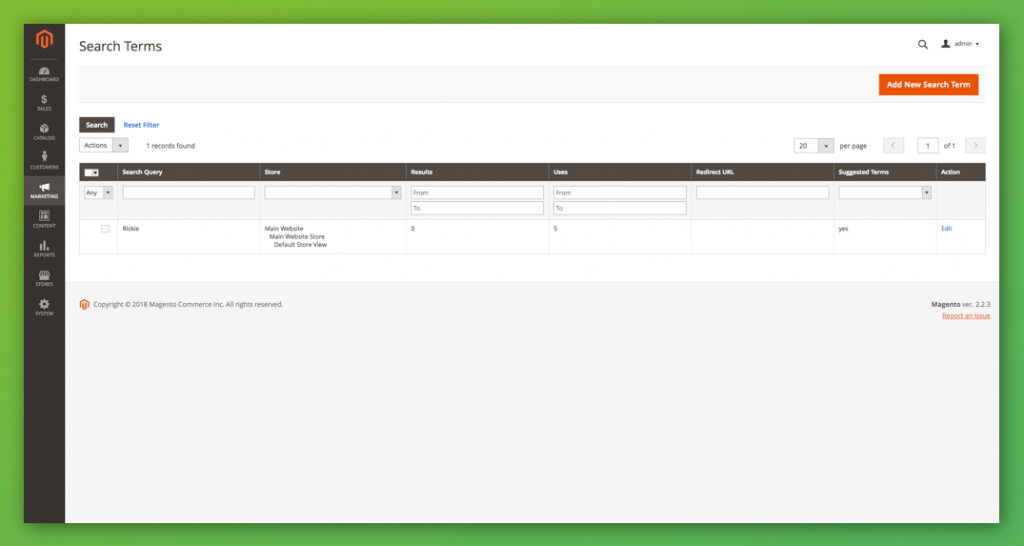
October 7,2021
3 Actionable Marketing Uses For The Magento Reports
When marketing for an ecommerce website, we want to be making sure we’re seeing as many sales as possible through the website, and that we’re using our time as effectively as possible to do this.
However, sometimes we might overlook useful resources that are at our fingertips, you’d be forgiven if you never looked much at the reports section for ideas to where you should be putting your efforts.
When you look at the reports tab, you might be mistaken to think that the things in here are what your accounts department or purchasing department might use to know how much revenue you’ve made, and which products you’ll need to order.
These reports are in there and are very much used for these departments, there is however, a wealth of knowledge your marketing department can find and use to make improvements to your website.
But before we look at how these reports can be utilised by your marketing department, we’ll take a quick look through common fields/options you’ll have over the report.

- Date Used: (Drop-down menu with options “Order created” and “order updated”) You have the option of defining how it picks which orders to show, by when they were created or last updated.
- Period: (Drop-down, options “day/month/year”) What time period you want the data to be split by, either day, month or year.
- From/To: (Calender select) The date range you want to check.
- Order Status: (Drop-down menu with all order statuses) Depending on what you want to see, you can see all orders for a specific period, or orders of various statuses, so you could check all completed orders, or cancelled or how many orders you’ve got pending.
- Empty Rows: (Drop-down menu with options for “No” and “Yes”) If ‘Yes’ is selected, then all days/months/years will be listed, regardless of if there’s any data to show, if ‘No’, these periods will be skipped.
- Show Actual Values: (Drop-down menu with options for “No” and “Yes”) If you select “No”, then your sales report will display projected values instead of actual values.
1. Orders Report
Report you’ll need:
Sales > Orders

There are a number of different reports in here, which all work in the same manner, so let’s take a look at the Orders report. Once you open this up, you’ll be shown this.
You might only use the Orders report for seeing how many orders/how much revenue you’ve made over a time period, but there’s more ways you can use this, actionable ways these can be utilised to improve your website.
What you should check:
- Which are your busiest and quietest days (e.g. weekend might be quieter), so you can see when your customers are buying and to push your marketing more then.
- Over a 12 month period, see a month by month breakdown of where your busiest months are, then use this to know when you should be arranging special offers to entice more people to buy from you.
- Are there any noticeable dips or peaks in transactions/revenue during any periods, look further into why this happened and see if it can be replicated.
There are a number of useful ways this can then be used to help you see where you might want to make changes to improve your efficiency.
2. Find products people add to cart, but don’t buy
Report you’ll need:
Marketing > Products in Cart Report

The amount of times a product was added to a shopping cart and the amount of times it was ordered. This can help you review if there’s any barriers to a product being sold, as if they’ve added it to cart, there must have been some desire to buy the product.
What you should check:
- Competitors, they may be selling the same or similar product at a more desirable price point.
- Are people put off by an additional charges at checkout, such as shipping costs.
- Are there other, similar products you list on your website (such as a cross or up sell), that are being purchased instead.
Once you know the cause of the issue, you can then work towards improving the conversion rates of those products.
3. Find highly viewed, but lowly purchased products
Reports you’ll need:
Products > Viewed, Products > Ordered

We’ll set an example scenario, if you were to set a month period for the products ordered report and the products viewed report, downloaded all the data and matched it up against each other, you could see how well a product sold, based on the amount of times it was viewed.
This could then help you find that there are products that are viewed a lot, but rarely ordered. With this information you can then start looking as to why this might be, is a competitor selling the same item for a better price? Is there an unexpected delivery charge? Is there an issue with the product page, that’s preventing people from ordering?
What you should check:
- The price, are their competitors selling the same product at a better price point.
- Are people put off by an additional charge, such as high shipping costs.
- Check other similar products, it could be that you have that people are drawn to a more popular cross-sell product.
- Your analytics to see how are people finding the product, if they’re coming from the search results, it could mean there’s an issue with the targeting, or are while browsing your website.
- The product page itself to see if it looks ok, look at things like the images, the description, how is the product being rpesented to customers.
- Stock, is the item available for people to buy, if not, you might want to set up a way to alert them when it’s available again.
Bonus: Search Term Report
Report you’ll need:
Marketing > Search Terms

We’ve talked about the usefulness of the Magento search term report previously, but we’ll talk about it here again briefly. This report lets you see the search terms people use on your website, this can give you a better insight into how and the way people are searching for your products. You can then use this information to better optimise your products.
You can also set the destination page for these searches, so if there’s a particular product they’re looking for, instead of sending them to the search results, you drop them straight on the product.
From here, you should check:
- What words are people using to search for the products, could these be used to improve product description optimisation for other users.
- How many search results show up when searched, instead of going to a search results page, would be better suited going directly to a product or category.
- Is there a particular range or product that’s commonly searched, should this be featured on the home page or as the first product in its category to help people more easily find those pages.
These simple things can all be done from the Magento 2 admin panel, and can give you better insight into potential problems your website has.
We are a experienced Magento Agency, working with brands both large and small. If you need any help with your Magento Store, get in touch with us today!




